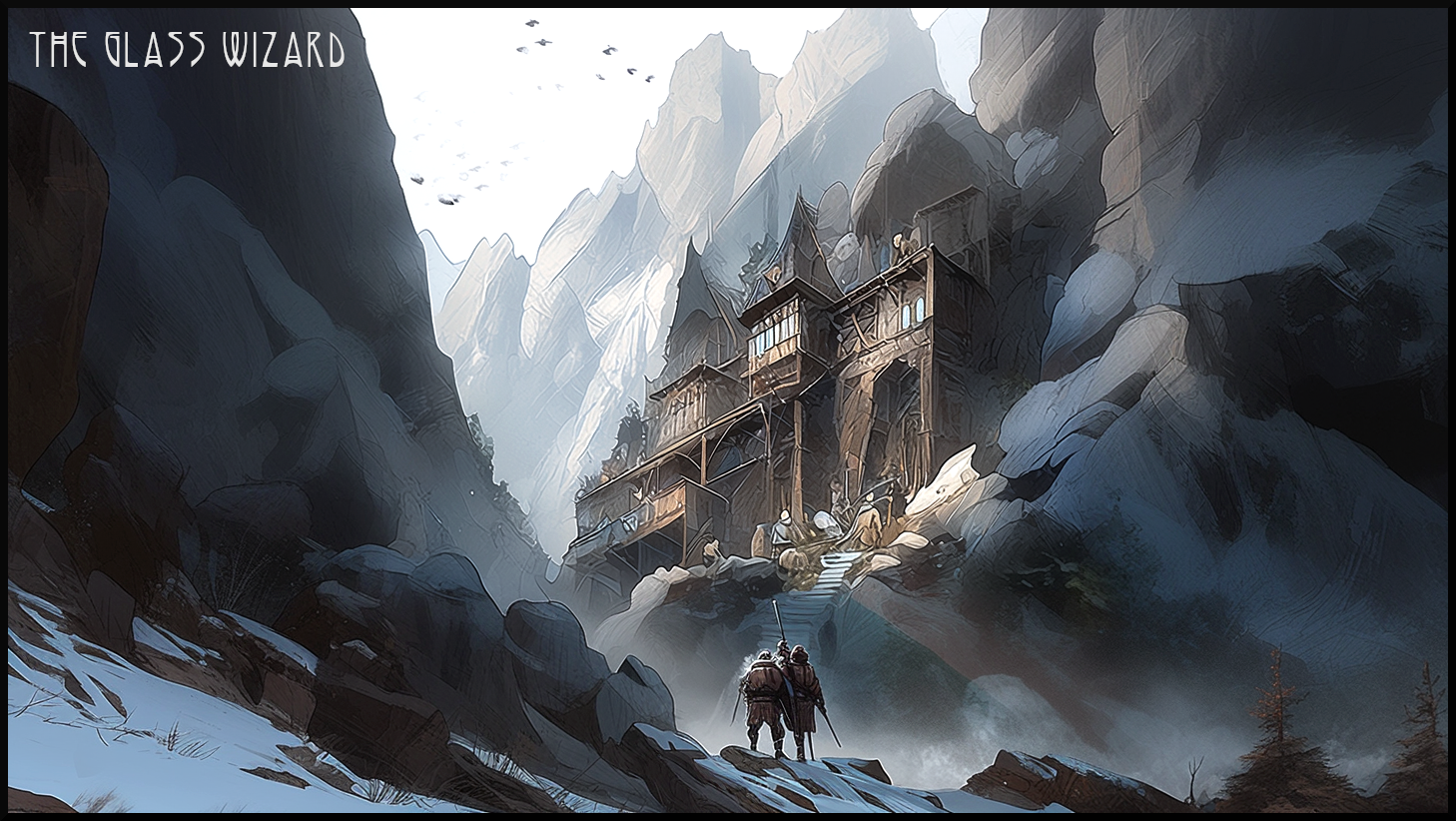
A glossary on guilds and similar organisations.
Guilds are unique organisations, each with its own purpose and structure. Some are tightly-knit societies, where specific peoples or professions unite under shared goals and traditions. Others are more open, welcoming travellers from all walks of life. These open guilds serve as hubs for exchange — whether it be knowledge, shelter, food, goods, or medical care. In a world of endless journeys and shifting alliances, guilds provide a vital network for those who seek both refuge and opportunity.
They are known to employ a mix of permanent residents and temporary recruits, who exchange their skills for food, shelter, and pay. Among them are seasoned fighters, spotters with exceptional senses, and sometimes even legendary treasure hunters and wizard scholars.
TRIVIA
GUARDS
Guilds are generally managed by a mix of residentual and temporary guards.
To some, the definition of "guard" is insultingly loose. Guards did not just watch and protect. They did everything. Every menial, tedious, degrading task even remotely connected to keeping the stream of travellers comfortable.
MESSENGER STRING SERVICE
It is common amongst adventurers and artefact hunters to leave messenger strings for each other in a guild when they embark on individual errands. Such strings, safeguarded by the guild, require no extensive quality or protection. Messages can also be sent directly via guilds using particularly high-quality strings. These strings do not need to be bought but remain the property of the guild and are delivered by individual guild couriers. Anyone can buy such services.
LAST LETTERS
It started with the Albweiss Mountain Guild, but by now, last letter boxes became a common guild feature. Travellers may leave such a letter before they continue with their journey or take up a quest from the guild. If the guild receives a credible confirmation of death of said traveller, they will forward their letter to the intended recipient.


Barnstream Harbour Guild
The Guild of Wanderers, Craftsmen and Fishermen
The Guild of Wanderers, Craftsmen and Fishermen
Found in the North-East of the Northlands, inlands amidst the various Barnstream villages. Situated next to the Barnstream river and thus easily accessible by those who travel the grand, interconnected lakes by ship. Amongst these frequent travellers are craftsmen and those who follow the harvests downstream.
FEATURES
▪ Apparently, there is a shrivelled, mummified ork head at display.
As the story progresses, information on this guild will be added.
PATRONS AND PROPRIETORS
As the story progresses, information on this guild will be added.
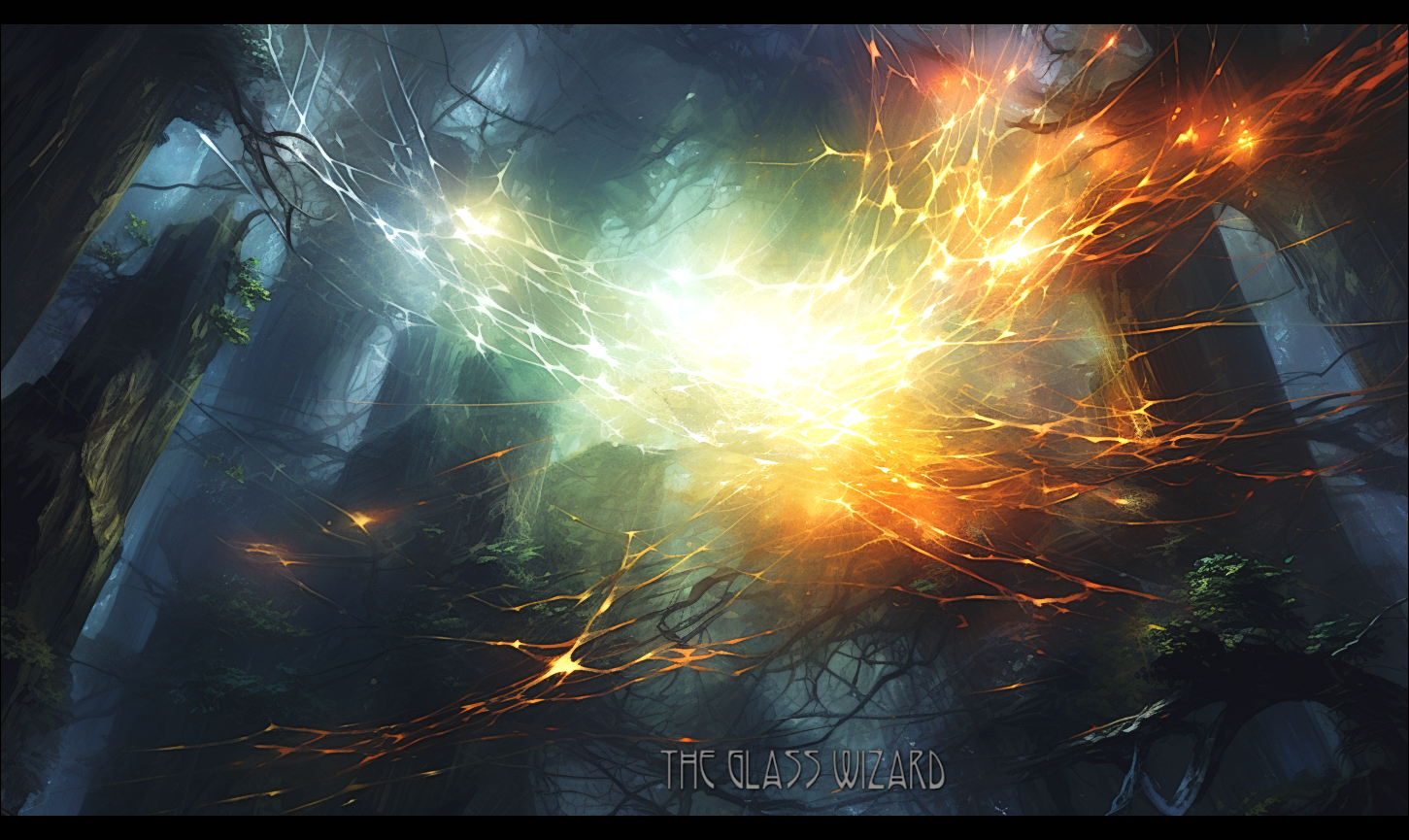


Albweiss Mountain Guild
A Refuge from the Nowhere-Snowtrail
A Refuge from the Nowhere-Snowtrail
“’Know thisss, hrrm, the guild, yesss, it is not simple shelter, no, but place of proving. Combatants sharpen blades. Wizards learn limits. They test. Against ice, stone, sky. Against themselves. Against what breaks.'” [Harrow in B1.C15]
Built into the mountain, the Albweiss Mountain Guild is a stone fortress nestled in a natural gap, a strategic shelter of five storeys offering relief from the unforgiving weather of the Albweiss. Its imposing structure features towers and lookouts that rise from the rock like an extension of the mountain itself, a testament to both ingenuity and necessity. The stone walls bear the marks of centuries of wind and ice.
The guild is a lifeline for the lost, a sanctuary for weary, and a haven for the brave. It serves as a refuge for travellers, a bastion for adventurers, and a hub for minor trade, marking the midpoint between the Barnstream Harbour Guild to the east and the Midland settlements farther south. Its reputation stretches across the Northlands, renowned for offering food, lodging, and supplies to those who brave the Snowtrail.
FEATURES
LOCATION
The guild’s position had been carefully chosen, situated in a region untouched by the larger beasts that roamed the higher peaks or the fetid swamps below. Predators rarely venture into the aligning stretch of the Snowtrail. Prey is scarce, save for the occasional travellers that wander the trail. The terrain itself is the ultimate deterrent. Narrow ravines that are permanently overrun by gushes of melting snow, steep cliffs, and an unrelenting cold create a natural fortress, dissuading even the boldest creatures from trespassing. It is this very isolation that had allowed humanoid peoples to establish a foothold, turning the uninhabited emptiness into a strategic advantage.
PROTECTION
The guild walls are several metres thick. It is heavily warded against most forms of elemental magic. Additional seals prevent intrusive spells, like the abilities witches use to access or manipulate minds. All protective enchantments are upheld through energy crystals, both openly displayed in the common room and others stored safely in designated rooms.
The guild's rooms are equipped with various weapons.
CARE
Apart from shelter and food, the guards provide medical care and supplies.
DESIGN
ENTRANCE
"The guild entrance was built for two kinds of visitors: the dangerous and the half-frozen." [B1.C18]
The western entrance features a massive double door made of metal. Behind, two passages open up, with a wall between them. One features a bench carved out of the wall stone, where travellers may wait and acclimatise before entering, while the other is used for swift entrance and exit.
After this walkway of three metres, a set of second doors leads into the common room, where the weary traveller is presented with an oversised garderobe that features rows of hooks for dripping coats, trays to catch meltwater from boots and gear, thick mats with various brushes to scrape off snow and grime, and two weapon stands. The shelves hold stacks of clean towels, with a second rack for the wet and used. There is also a metal mailbox for last letters.
COMMON ROOM
The common room is a utilitarian space, built for endurance rather than comfort. Dark stone walls loom, their uneven surfaces pocked with scars from age and wear. A massive hearth dominates one side, its iron grate blackened by the smoke of countless fires. A single long sofa and two chairs sit beside it, worn but sturdy. Above them hangs a battered pike, its edge sharp.
Heavy wooden tables stand in neat rows, their surfaces gouged and stained, the wood permanently darkened by years of use. The chairs are equally robust. They come in varying sizes and shapes to accommodate the diverse travellers who pass through. Some have wide backs, armrests, and leather padding; others are plain, meant for bodies that require little in the way of comfort — or more room for spikes, wings, and the like.
Two large tapestries adorn the walls. One depicts an abstract swirl of smoky figures, locked in some battle. The other shows a forest beneath a blood-red sky with gnarled and twisted trees. If one stares too long, the shadows between them seem to shift. There are portraits, too. One of a wizard, or perhaps a tairan, clad in a uniform. The other of what is probably a female shaman, far gone in her transformation.
Some defenses are subtle, others blatant. Iron reinforcements brace the doors and windows, which have shutters on both the inside and outside. A loaded crossbow is mounted near the kitchen entrance. Another hangs by the stairs, alongside two swords and a wizard’s staff.
KITCHEN
The kitchen is connected to the common room by a swinging half-door followed by a short walkway and another door. There is also a pass-through that serves as a window between both rooms. It is a simple cut-out in the wall between the half-door and the stairs leading to the upper floors. A broad wooden ledge lines the opening, a place for setting down plates. From there, one may catch the sharp tang of smoked spices, fire, and simmering broth, tangled with the ever-present undercurrent of ale that has long since soaked, seeped and settled within the wood.
In core, the kitchen is a place of contradictions: practical, rugged, yet layered with unsettling details. It is carved deep into the stone foundations of the guildhall, its smooth grey walls polished to a sheen. Their surfaces are punctuated with iron hooks that bear hanging utensils, cast-iron skillets, and bundles of dried herbs. Their sharp, earthy scents mingle with the tang of whatever is cooking in two massive iron pots situated over the open hearth.
Behind the hearth is the door to the sick by. It sits flush at the back of the left wall, dull and stone-coloured, betrayed only by the narrow window, which is but a slit of glass.
At the heart of the room stand two large tables made of heavy wood. Their surfaces are etched with knife marks, burns and wear. Their edges gleame with steel reinforcements, as do the heavy stools surrounding them. They are built from the same dark wood and have legs fortified with iron brackets to withstand weight and strain. The floor is marked by grooves; thin, deliberate channels carved into the rock, running toward unseen drains before vanishing beneath the stonework. Concealed passageways, meant for water — or blood.
The entire room is a fortress masquerading as a kitchen, as much battlefield as hearth. Some defences are subtle — the steel-braced tables and cabinets, the iron grating over the narrow window. Others are not. In one corner stands a double-tiered rack of weapons, things obviously not meant for cooking; knives, blades and two spears. A crossbow hangs just above, quarrels lined beside it. Likewise, the present tools double as instruments for surgery. "Because what stopped you from doing to people what you could do to animals" [B1.C18].
Water can be accessed through a large sink opposite the hearth. It was cut from the same stone as the wall, with a crude pipe system much like the one in the bathroom: one singular spout above, and one broad drain below, at the centre of the sink. Like with the barrel and the toilet, a thin slate blocks the downward outflow. When pulled, a stream gushes forth, striking the basin and spreading over the darkened trough before coiling into the drain.
The decoration is sparse but distinct. Above the blackened stone fireplace hangs a large painted canvas: A storm-lashed seascape, waves rising like clawed hands. A ship breaking apart in the maelstrom. And there, rising from the depths, dark, coiling shapes, serpent-like, monstrous, their forms barely distinguishable from the shadows of the storm, writhing between wave and abyss. It is grotesque and full of dread. Another cancas is mounted above the cabinets, showing battlefield drowned in horror. Humanoid figures, clawing and twisting, their forms devoured beneath a horde of grotesque, many-limbed creatures — grand, distorted arachnids that seem to spill from the wall.
SICK BAY AND SURGERY
A separate door leads from the kitchen hallway to the sick bay.The separate surgery lies between the sick back and the kitchen and may be accessed from both.
SICK BAY
As with the whole guild, the walls are hewn straight from the mountain. They are lined with shelving carved directly into the stone, occasionally interrupted by neat rows of iron-braced cabinets and open racks that hold various medical tools. The educated eye would recognise bone drills, splints for setting jaws and limbs, and iron hooks for drawing back flesh during surgery. Leather straps hang coiled beside tourniquet belts fitted with wooden windlasses to tighten them. Cautery irons, their tips darkened from countless heatings, lie on a stone tray next to slender probes for exploring wounds, and lengths of smoked sinew for binding fractures.
Earthen jars and wooden boxes hold dried poultices, powders, and herbal compresses, while other vials are stored submerged in clear bowls of shredded ice that glints dully in the dim light of the orbs overhead. Elegant metal boxes hold syringes made of horn and brass, intended for both irrigation and injection. Bigger boxes store layers of folded linen bandages covered in malraw and crushed fusalis, while carefully distinguished rows of untreated cloth sit stacked near the door. The air is thick with the scent of tinctures, layered over the strong smell of various herbs and potent spirits; the guild’s pungent arsenal against frostbite, rot, and poison.
Five cots line against the far wall. The cots are skeletal things, frames of hammered iron with joints blackened from fire. No two are alike. All are different sizes, built for bodies of various shape. They are fitted with stretchers which facilitate transportation and cleaning.
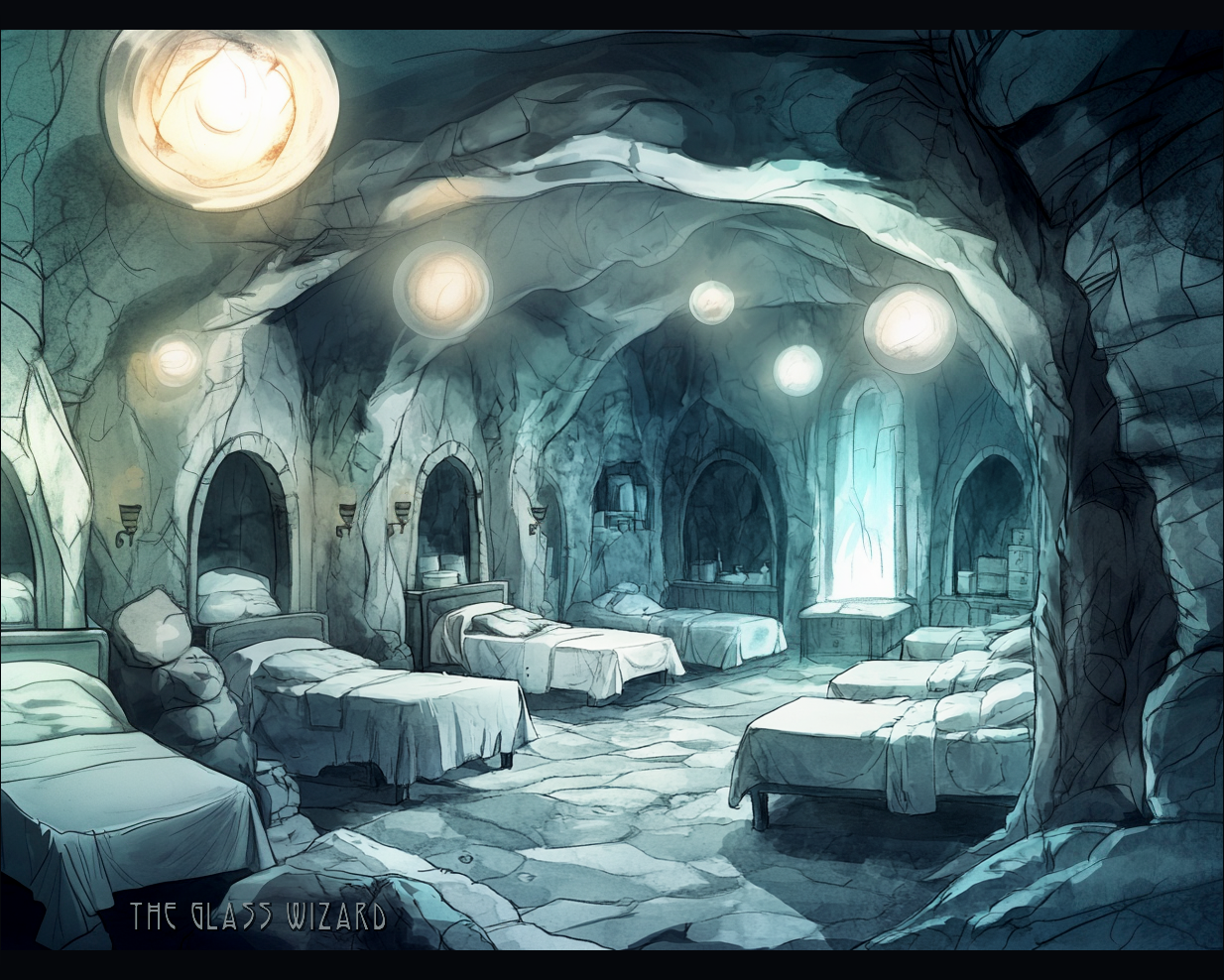
SURGERY
This room serves as a dedicated space for surgical procedures ... or any butchering tasks. Conveniently situated between the sick bay and the kitchen and stuffed to the brim with tools for both tasks, it provides easy access for both medical staff and those handling food preparation — both currently done by Bubs.
"It was bare and cold, a surgery stripped to its bones. At its centre stood a massive slab of stone, hacked raw from the mountain except for its surface, which had been sanded to a flat, pale gleam. Its crooked base fused into the floor like roots. From each side hung broad metal plates, hinged to fold upward, so the block could be widened to hold even a borman.
The walls bore shelves heavy with tools that looked stolen from a butcher’s stall or a battlefield. Some were shaped like weapons, others like farm equipment. Their purposes wavered between repair and mutilation. Some had no clear use at all. Yu’s eyes flew over them and fled just as quickly; iron spreaders with ratcheting arms, bone levers wicked in curve, clamps wide as wings, tongs barbed like fishhooks — for pulling, holding, or tearing? As he spotted a whole array of saws, he forced his gaze lower, from the walls to the subtler things on the workbenches: kits of bone-handled needles, chisels as thin as quills, hammers with flat heads, wedges meant for splitting things apart, pincers that were nothing but angles and edges, and all right thank you that is enough." [B1.C18]
ACCOMMODATION
Private and multi-bed rooms are located on the first and second floor, with communal washrooms.
In the bathroom, fresh water is supplied through stone pipes that connect to the outside. They are directly hewn into the wall and connect to an outsie source.One of these pipes feeds water into a simple stone toilet, while the other directs it into a large stone barrel. For those who fit in, the barrel may be used for bathing. For those who simply wash themselves instead, a ladle can be used to scoop water from the barrel, which can then be poured into the sink. While the toilet drains instantly, there is an outlet at the bottom of the barrel that my be opened by pulling a block of stone on the floor, outside of the barrel.
Though simple, the design provides an effective means of managing water and waste, maintaining cleanliness and functionality within the guild.
CELLAR
The cellar has been mentioned in [B1.C19] but has not yet been explored.
PATRONS AND PROPRIETORS
"'The guild, it bends blades, sharpens minds, yesss, makes those who test their limits … whole — or broken, hrrm. A forge. But fire is the mountain.'” [B1.C15]
In contrast to the Northern Desert, the Albweiss is rich in Adhar for such training. With that, the guild attracts a diverse and ever-changing population, including wandering mercenaries, hunters, and explorers.
GUARDS
"Stories circulated of young patrol guards stumbling upon pieces of treasure — an abandoned artefact here, coin and jewellery there. These tales, of course, often served more as recruitment bait than truth, meant to entice new guards with the promise of fortune. After all, it was quite easy to convince someone to take a job by claiming the previous guard had struck it rich and retired. It was nicer too, to think of them living it up and feasting upon all that their newfound treasures could buy, instead of admitting that they had been long feasted upon by the Haraak." [B1.C15]
All guards are sworn into and released from their duty via a ceremony. Present guards carry a miniature rendering of the coat of arms that adorns the wooden plaques throughout the guild building.
RESIDENTUAL GUARDS
▪ The Watch-Captain. Currently on patrol. Apparently.
▪ Terbert. Lives in the walls and appears when the time is right. Whatever the fuck that means.
▪ Bubs. Mianid. Guild chef. May feed or poison you. Also responsible for medical care.
▪ Deltington and Estingar. Ulbatans. Brothers.
▪ Gurs Farr-Rah. Borman.
▪ Shaman of the Guild. Identifies those marked by witches. About to leave after residing for eight months.
▪ Tirran. Omira. Very competent and well-mannered. Still scares the shit out of everyone by being there.
▪ Yu. Fina-Wizard-bastard with no arms. Transcender with exceptional hearing.
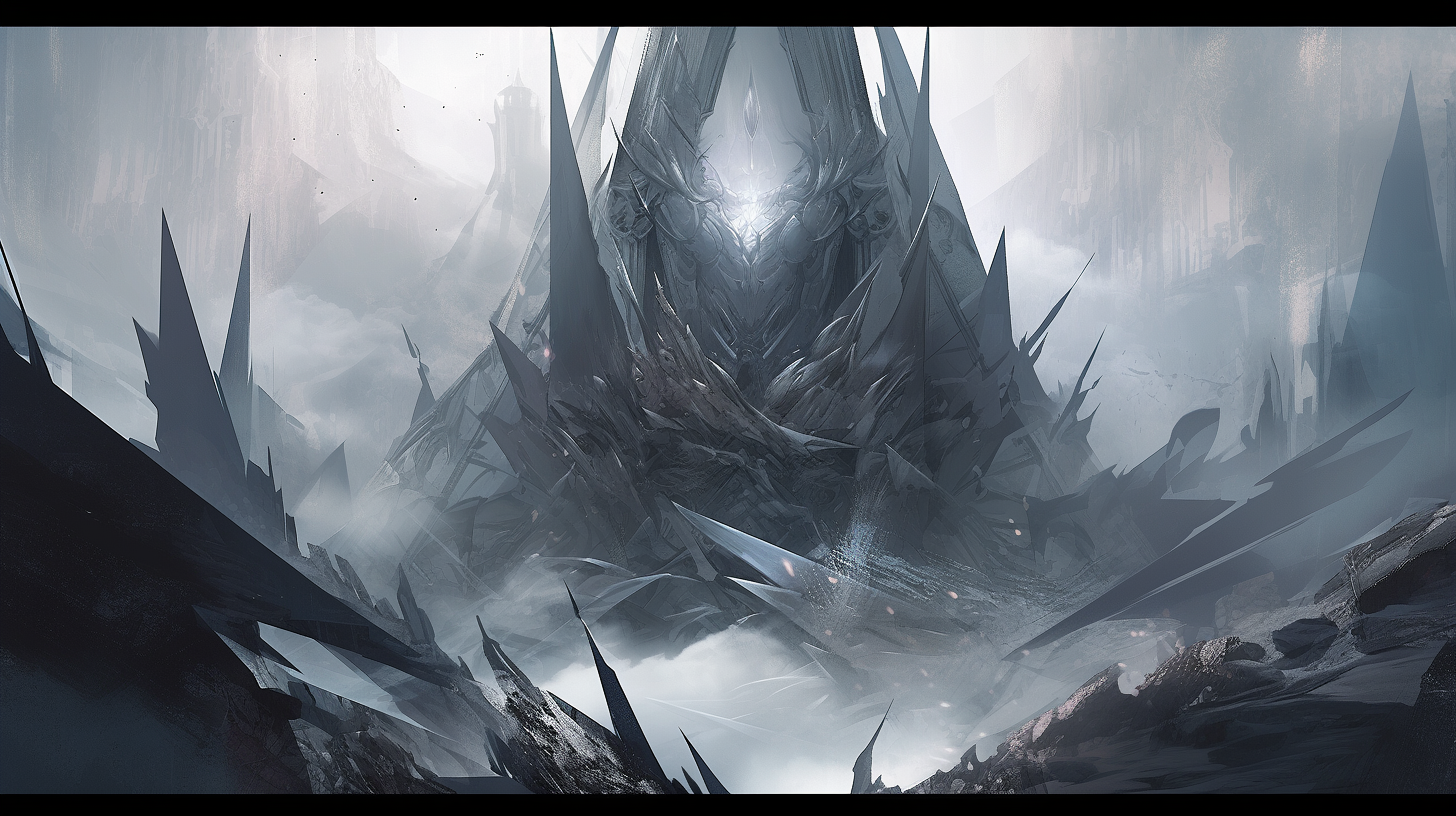
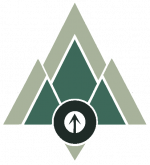

Millondathill Guild
A Prominent Accident
A Prominent Accident
“Excuse me, where can I find the guild outpost of his town?”
– “We don’t have one, I’m afraid, but adventurers generally camp out in the abandoned mill on that hill.”
As the story progresses, information on this guild will be added.
FEATURES
As the story progresses, information on this guild will be added.
PATRONS AND PROPRIETORS
As the story progresses, information on this guild will be added.




